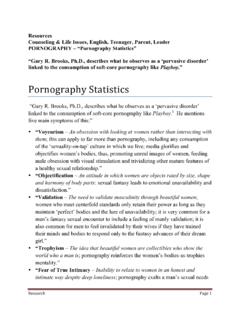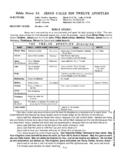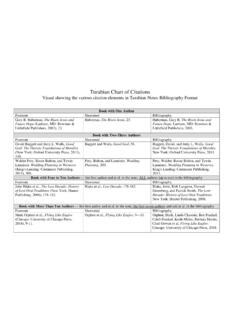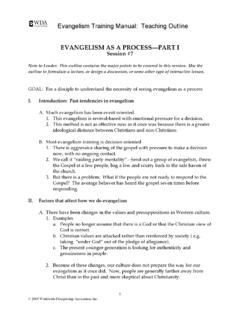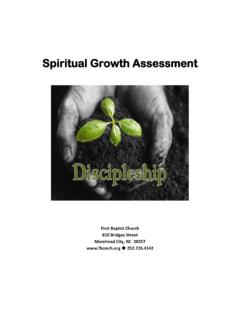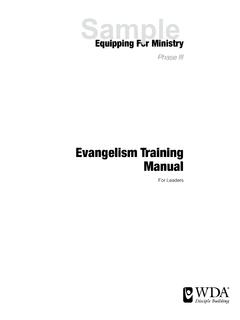Transcription of F O R T H E R E S U R R E C T I O N - Josh McDowell
1 F O R T H E R E S U R R E C T I O N By Josh McDowell C hrist s resurrection is as relevant today as it was in the first century our pre-sent and eternal lives depend upon it. Easter happened. The resurrec-tion is an historical and living reality that can empower us to live a life full of meaning and purpose. A student at the University of Uru-guay said to me, "Professor McDow-ell, why can't you refute Christianity?" "For a very simple reason," I answered. "I am not able to explain away an event in history the resur-rection of Jesus Christ.
2 " How can we explain the empty tomb? Can it possibly be accounted for by any natural cause? A QUESTION OF HISTORY After more than 700 hours of studying this subject, I have come to the conclusion that the resurrection of Jesus Christ is either one of the most wicked, vicious, heartless hoaxes ever foisted on the minds of human beings or it is the most remarkable fact of history. Here are some of the facts relevant to the resurrection: Jesus of Naz-areth, a Jewish prophet who claimed to be the Christ prophesied in the Jewish Scriptures, was arrested, was judged a political criminal, and was crucified.
3 Three days after His death and burial, some women who went to His tomb found the body gone. In subsequent weeks, His disciples claimed that God had raised Him from the dead and that He appeared to them various times before ascend-ing into heaven. From that foundation, Christianity spread throughout the Roman Em-pire and has continued to exert great influence down through the centuries. LIVING WITNESSES The New Testament accounts of the resurrection were being circu-lated within the lifetimes of men and women alive at the time of the resur-rection. Those people could certainly have confirmed or denied the accuracy of such accounts.
4 The writers of the four Gospels either had themselves been witnesses or else were relating accounts of eye-witnesses of the actual events. In advocating their case for the Gospel, a word that means "good news," the apostles appealed (even when confronting their most severe oppo-nents) to common knowledge concerning the facts of the resurrection. F. F. Bruce, Ryland s Professor of Biblical Criticism and Exegesis at the University of Manchester, says con-cerning the value of the New Testa-ment records as primary sources: "Had there been any tendency to depart from the facts in any material respect, the possible presence of hostile witnesses in the audience would have served as a further corrective.
5 " IS THE NEW TESTAMENT RELIABLE? Because the New Testament provides the primary historical source for information on the resurrection, many critics during the 19th century attacked the reliability of these biblical documents. By the end of the 19th century, how-ever, archaeological discoveries had confirmed the accuracy of the New Testament manuscripts. Discoveries of early papyri bridged the gap between the time of Christ and existing manuscripts from a later date. Those findings increased scholarly confidence in the reliability of the Bible. William F.
6 Albright, who in his day was the world's foremost biblical archaeologist, said: "We can already say emphatically that there is no longer any solid basis for dating any book of the New Testament after about 80, two full generations before the date between 130 and 150 given by the more radical New Testament critics of today." Coinciding with the papyri discover-ies, an abundance of other manu-1 2 s c r i p t s c a m e t o l i g h t ( o v e r 2 4 , 0 0 0 copies of early, New Testa-ment manuscripts are known to be in existence today). The historian Luke wrote of "authentic evidence" con-cerning the resurrection.
7 Sir William Ramsay, who spent 15 years attempting to undermine Luke's credentials as a historian and to refute the reliability of the New Testa-ment, finally concluded: "Luke is a historian of the first This author should be placed along with the very greatest of historians." B A C K G R O U N D The New Testament witnesses were fully aware of the background against which the resurrection took place. The body of Jesus, in accor-dance with Jewish burial custom, was wrapped in a linen cloth. About 100 pounds of aromatic spices, mixed together to form a gummy substance, were applied to the wrappings of cloth about the body.
8 After the body was placed in a solid rock tomb, an extremely large stone men who were responsible. If they were apprehended, it meant automatic execution by crucifixion upside down. People feared the breaking of the seal. Jesus' disciples displayed signs of cow-ardice when they hid themselves. Peter, one of these disciples , went out and denied Christ three times. Fact #2: Empty Tomb As we have already discussed, another obvious fact after the resur-rection w as the empty tomb. The disciples of Christ did not go off to Athens or Rome to preach that Christ was raised from the dead.
9 Rather, they went right back to the city of Jerusalem, where, if what they were teaching was false, the falsity would be evident. The empty tomb w as "too notori ous to be deni ed." Paul Althaus states that the resurrection "could have not been maintained in Jerusalem for a single day, for a single hour, if the emptiness of the tomb had not been established as a fact for all concerned." Both Jewish and Roman sources and traditions admit an empty tomb. Those resources range from Josephus to a compilation of fifth-century Jewish writings called the "Toledoth Jeshu.
10 " Dr. Paul Maier calls this "positive evidence from a hostile source, which is the strongest kind of historical evidence. In essence, this means that if a source admits a fact decidedly not in its favor, then that fact is genuine." Gamaliel, who was a member of the Jewish high court, the Sanhedrin, put forth the suggestion that the rise of the Christian movement was God's doing; he could not have done that if the tomb were still occupied, or if was rolled against the entrance of the tomb. Large stones weighing approxi-mately two tons were normally rolled (by means of levers) against a tomb entrance.

